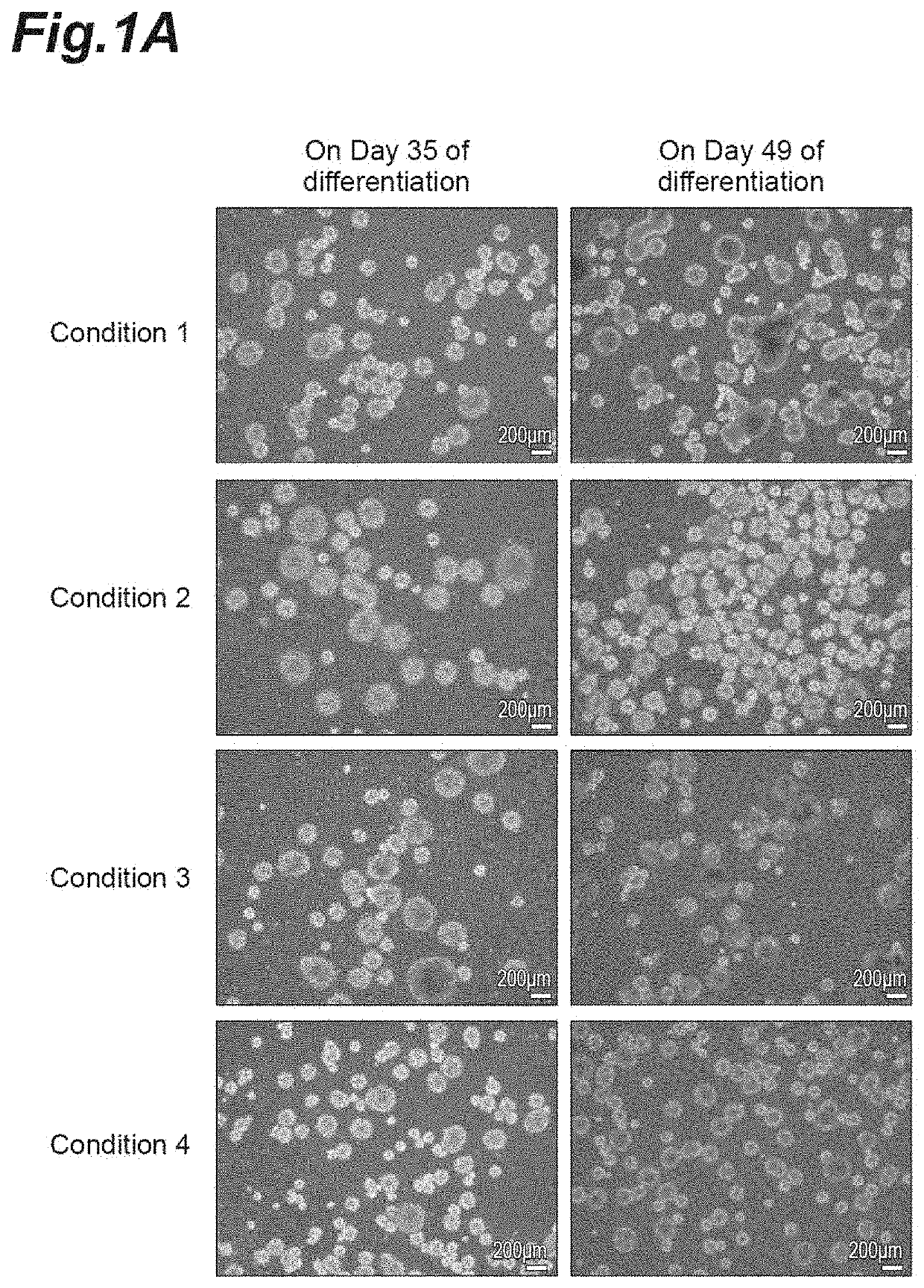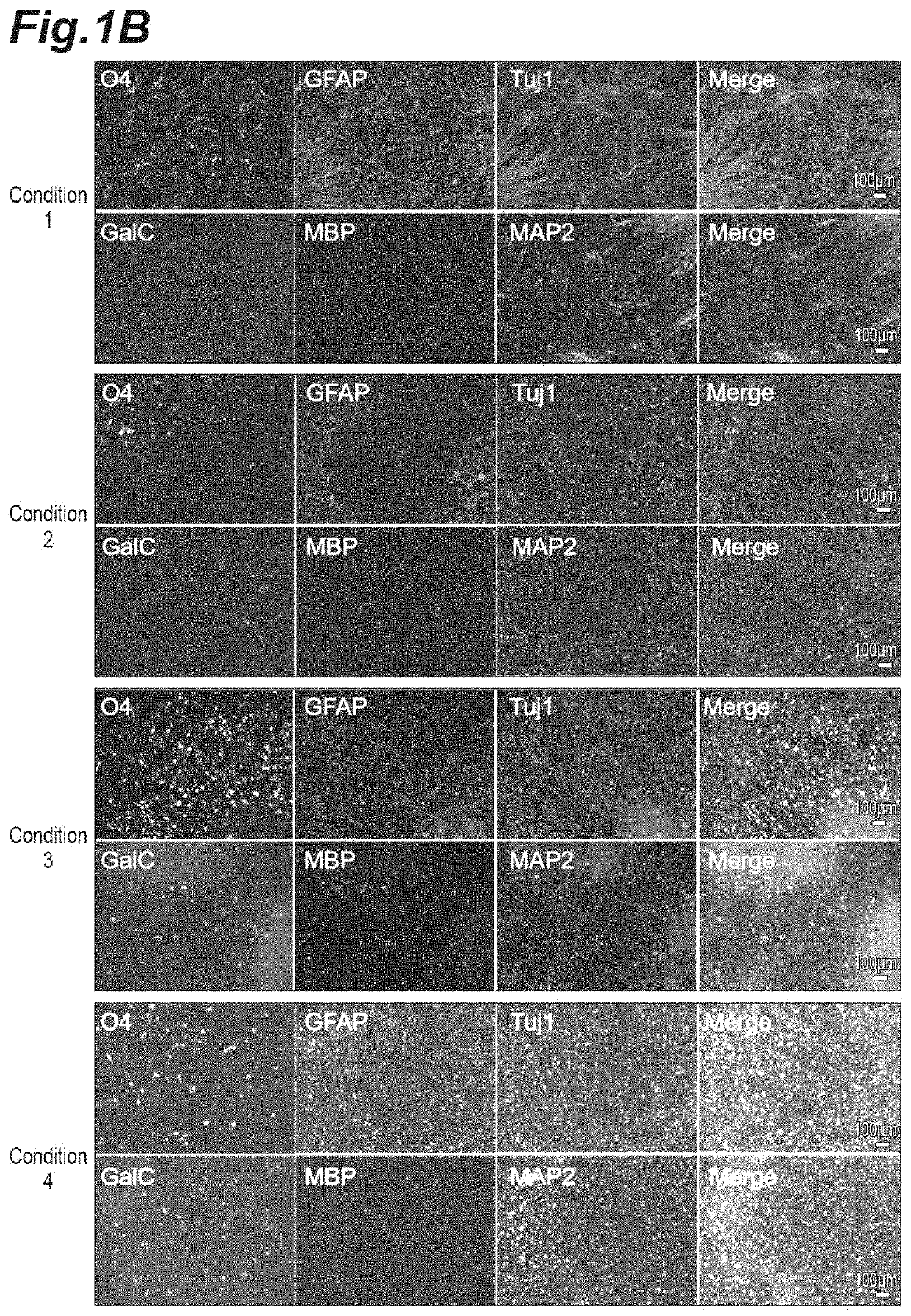Method for Producing Cell Aggregate Including Glial Progenitor Cells
a technology of glial progenitor cells and cell aggregate, which is applied in the field of cell aggregate, can solve the problems of loss of glial cells forming, serious cases, axonal degeneration and cell body degeneration,
- Summary
- Abstract
- Description
- Claims
- Application Information
AI Technical Summary
Benefits of technology
Problems solved by technology
Method used
Image
Examples
example 1
n of Cell Aggregate
[0285]A QHJI01 s04 strain, which is a clinical grade peripheral-blood-derived feeder-free iPS cell line established by Center for iPS Cell Research and Application, Kyoto University, was used as an iPS cell line. Before differentiation, the iPS cell line was subjected to maintenance culture in StemFit® AK03N culture medium (manufactured by Ajinomoto Co., Inc.) supplemented with laminin 511E8 fragment (iMatrix-511E8; manufactured by Nippi, Incorporated) (0.5 mg / ml).
[0286]To induce differentiation of iPS cells into neural progenitor cells, a serum-free aggregation / suspension culture method (SFEBq method) was used for embryoid body formation. Specifically, the QHJI01s04 strain subjected to maintenance culture was separated into single cells with 0.5× TrypLE Select (manufactured by Thermo Fisher Scientific Inc.) / 0.25 mM EDTA (ethylenediaminetetraacetic acid) / PBS (phosphate-buffered saline, manufactured by Thermo Fisher Scientific Inc.), the cells were seeded on a 96-w...
example 2
ization of Cell Aggregates—Part 1 (Gene Expression Change During Induction of Differentiation
[0295]To examine gene expression change during induction of differentiation, gene expression analysis by RNA-sequencing was carried out for intermediate products in induction of differentiation. Induction of differentiation was initiated with use of the QHJI01s04 strain in accordance with the method of condition 3 in Example 1, total RNA was extracted from cells before differentiation (iPS cell line), on day 7, 14, 21, and 35 of differentiation by using an easy Plus Mini kit (manufactured by QIAGEN), a library was prepared by using a TruSeq Stranded mRNA Library Prep kit from Illumina, Inc., and sequencing in 80 cycles was performed by using a HiSeq 2500. Gene expression analysis was performed with data of 30000000 or more reads per cell (FIGS. 3A to 3D).
[0296]Results of comparison of gene expression profiles before induction of differentiation (iPS cells) and on day 7 of differentiation fou...
example 3
ization of Cell Aggregates—Part 2 (Immunofluorescence Staining for Cell Aggregates)
[0297]Cell aggregates including glial progenitor cells were produced with use of an Ff-WJ14s01 strain, which is a cord-blood-derived feeder-free iPS cell line established by Center for iPS Cell Research and Application, Kyoto University, as an iPS cell line in accordance with the method of condition 3 in Example 1, and immunofluorescence staining for different differentiation markers were carried out. In the immunofluorescence staining, eight primary antibodies and fluorescence-labeled secondary antibodies corresponding thereto were used. Two or three primary antibodies were mixed together as shown in Table 5, and diluted with blocking solution to prepare three primary antibody solutions (primary antibody solution 1, primary antibody solution 2, and primary antibody solution 3). Similarly, two or three secondary antibodies were mixed together as shown in Table 5 with further addition of Hoechst 33342 ...
PUM
 Login to View More
Login to View More Abstract
Description
Claims
Application Information
 Login to View More
Login to View More - R&D
- Intellectual Property
- Life Sciences
- Materials
- Tech Scout
- Unparalleled Data Quality
- Higher Quality Content
- 60% Fewer Hallucinations
Browse by: Latest US Patents, China's latest patents, Technical Efficacy Thesaurus, Application Domain, Technology Topic, Popular Technical Reports.
© 2025 PatSnap. All rights reserved.Legal|Privacy policy|Modern Slavery Act Transparency Statement|Sitemap|About US| Contact US: help@patsnap.com



